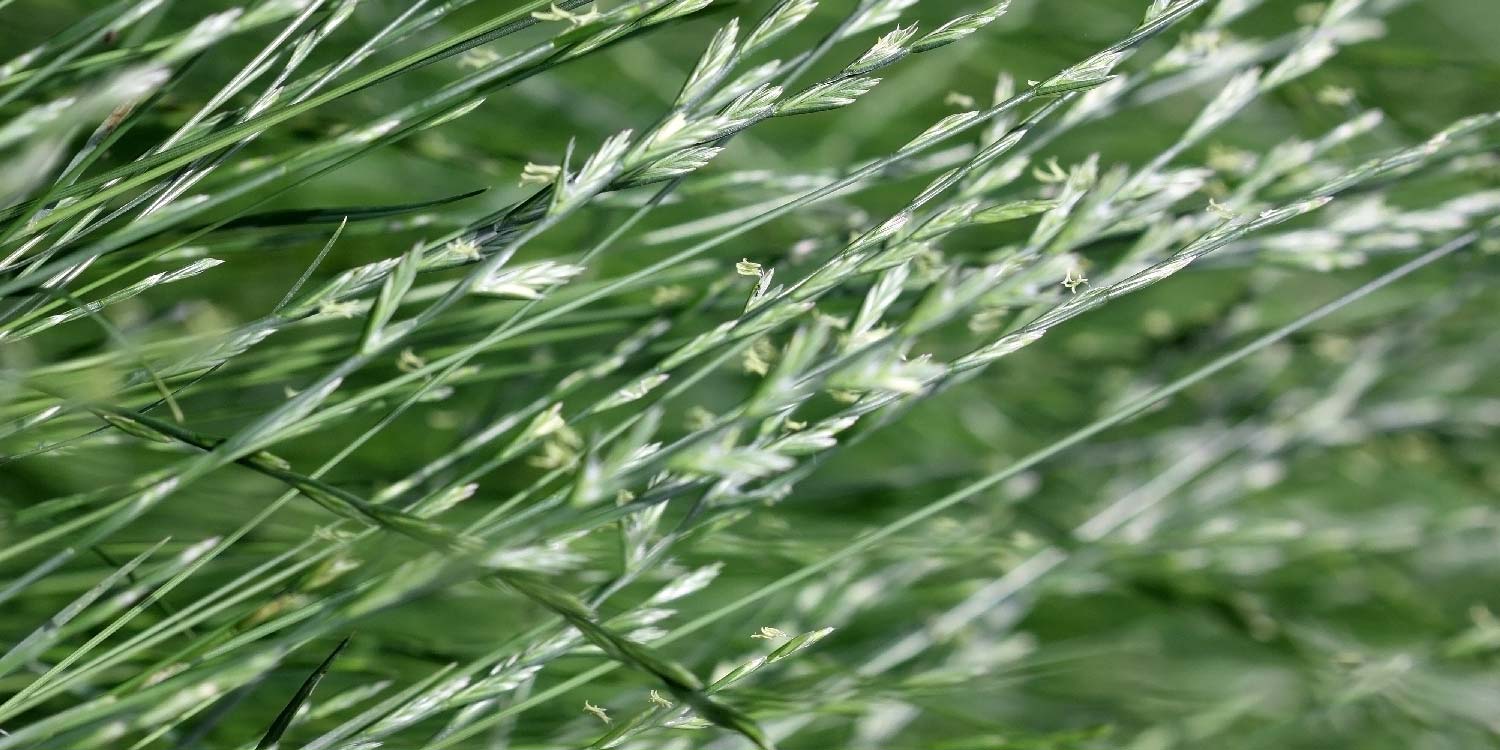Lolium is a genus of tufted grasses in the bluegrass subfamily of the grass family. It is often called ryegrass, but this term is sometimes used to refer to grasses in other genera.
They are characterized by bunch-like growth habits. Lolium is native to Europe, Asia and northern Africa, as well as being cultivated and naturalized in Australia, the Americas, and various oceanic islands.
Ryegrass should not be confused with rye, which is a grain crop
Description
The plant is a low-growing, tufted, hairless grass, with a bunching (or tillering) growth habit. The leaves are dark green, smooth and glossy on the lower surface, with untoothed parallel sides and prominent parallel veins on the upper surface.
The leaves are folded lengthwise in bud (unlike the rolled leaves of Italian ryegrass, Lolium multiflorum) with a strong central keel, giving a flattened appearance. The ligule is very short and truncate, often difficult to see, and small white auricles grip the stem at the base of the leaf blade. Leaf sheaths at the base are usually tinged pink and hairless. Stems grow up to 90 cm. It has auricles.
The inflorescence is unbranched, with spikelets on alternating sides edgeways-on to the stem. Each spikelet has only a single glume, on the side away from the stem, and between 4 and 14 Florets without awns, unlike Italian ryegrass. The anthers are pale yellow, and the plant flowers from May to November. Perennial ryegrass has a fibrous root system, with thick main roots and thinner lateral branches. Roots are usually arbuscular mycorrhizal.
Physiology and Growth of Ryegrass
The management of economic yields of Lolium sp. in grassland agriculture depends on sound knowledge of plant growth and development. Several features of Lolium physiology and morphology play critical roles in growth, development, and plant productivity. For example, the ryegrass seedling has the greatest rate of growth among cultivated cool-season grasses. This feature gives ryegrass an effective competitive edge in crop or pasture establishment.
Further development of the seedling gives rise to leaves and tillers. The tiller, branch or shoot on a ryegrass plant, is the fundamental demographic unit of the ryegrass stand. The fate of tillers is the major determinant of productivity in ryegrass plant populations. The growth environment, as affected by both the natural climatic and edaphic conditions and the influence of management practices, can modify the growth and development of ryegrass. Irradiance and temperature are the most important environmental parameters affecting photosynthesis and hence ryegrass growth and development. Soil N status is the largest single nutrient factor affecting ryegrass growth and development.
Damages or Losses Caused By Ryegrass or Disadvantages of Ryegrass as Weed
- Reduction in crop yield: Weeds compete for water, nutrients & light. Being hardy & vigorous in growth habit, they soon outgrow the crops & consume large amounts of water & nutrients, thus causing heavy losses in yield. E.g.: 40% reduction in yield of groundnut & 66% reduction in yield of chilli. The loss of N through weeds is about 150 kg/ha.
- Increase in the cost of cultivation: One of the objects of tillage is to control lolium on which 30% expenditure is incurred and this may increase more in heavy infested areas & also cost on weed control by weeding or chemical control. Hence, reduce margin of net profit.
- Quality of field produce is reduced: Weed seeds get harvested & threshed along the crop produce which lowers the quality. Such produce fetches fewer prices in the market. E.g.: Leafy vegetables, grain crop.
- Harbour insect-pests & disease pathogens: Weeds either give shelter to various insect pests & disease pathogens or serve as alternate hosts & thus helps in perpetuating the menace from pests & diseases. E.g.: Gall fly of paddy, midge fly of Jowar, leaf minor of soybean & Groundnut, rust of Wheat, tikka of Groundnut, Black rust of wheat, Downey mildew (Saccharum spontaneum).
- Check the flow of water in irrigation channels: Weeds block drainage & check the flow of water in irrigation canals & field channels thereby increasing the seepage losses as well as losses through over through over flowing, so reduce the irrigation efficiency.
- Reduce value of the lands: Heavily infested lands with perennial weeds fetch less price as require heavy expenditure to bring under cultivation.
Management and control of Ryegrass as a weed
GREENLIFE SOLUTIONS FOR THE CONTROL OF RYEGRASS
Herbicides can be defined as crop- protecting chemicals used to kill weedy plants or interrupt normal plant growth. Herbicides provide a convenient, economical, and effective way to help manage weeds.
Greenlife crop Protection has the best Non- selective and Selective herbicides for controlling annual and perennial a grass and broad leaved (Ryegrass). The herbicides includes:
- WEMBE 200 SL a non-selective post emergence herbicide, to clear Annual and perennial grasses (Ryegrass) and broad leaved weeds and any other weed in the field including difficult weeds. Use during Land preparation to clear all weeds.
Rate of use: 3.0Litres per Hectare (300ml in 20L) - CATAPULT 480 SL a non-selective Post emergence herbicide which controls Annual and perennial grasses (Ryegrass) and broad leaved weeds. Use CATAPULT 480 SL during Land Preparation to clear all weeds.
Rate of Use: 2.0Litres per Hectare (250ml in 20L) - DIGESTER SUPER 69 EW
Selective post emergence herbicide for control of grasses (Ryegrass) only on Wheat, Barley and Rice. Should be applied when weeds are actively growing.
Rate of Use: 0.75-1.0Litres per Hectare (75-100ml in 20L)






